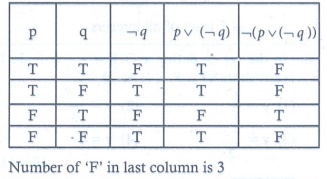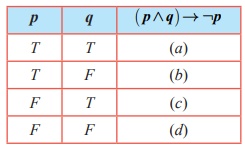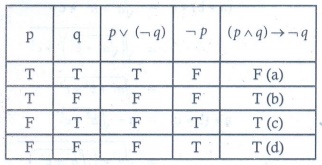Chapter 12: Discrete Mathematics - Online Test
Q1. Which one is the inverse of the statement ( p ∨ q ) → ( p ∧q) ?
Answer : Option D
Explaination / Solution:


Q2. Which one is the contrapositive of the statement
( p ∨ q ) → r ?
Answer : Option A
Explaination / Solution:


Q3.
The
truth table for ( p ∧ q
) ¬q is given below

Which one of the following is true?
Answer : Option C
Explaination / Solution:


Q4. In the last column of the truth table for ¬ ( p ∨¬q) the number of final outcomes of the truth value
' F ' are
Answer : Option C
Explaination / Solution:


Q5. Which one of the following is incorrect? For any
two propositions p and q , we have
Answer : Option C
Explaination / Solution:
No Explaination.
Q6.

Which
one of the following is correct for the truth value of (
p ∧ q)→
¬ p?
Answer : Option B
Explaination / Solution:


Q7. The dual of ¬ ( p ∨ q)
∨ [ p ∨( p ¬r)] is
Answer : Option D
Explaination / Solution:


Q8. The proposition p ∧
(¬p ∨ q) is
Answer : Option C
Explaination / Solution:


Q9. Determine the truth value of each of the following
statements:
(a)
4 + 2 = 5 and 6 + 3 = 9
(b)
3+ 2 = 5 and 6 + 1 = 7
(b)
4 + 5 = 9 and 1+ 2 = 4
(d)
3+ 2 = 5 and 4 + 7 =11
Answer : Option A
Explaination / Solution:
a) F and T=F
b) T and T=T
c) T and F=F
d) T and T=T
Q10. Which one of the following is not true?
Answer : Option D
Explaination / Solution:
If p
and q are any two statements then p ↔ q is a
tautology.
p ↔ q is actually a contingency.
